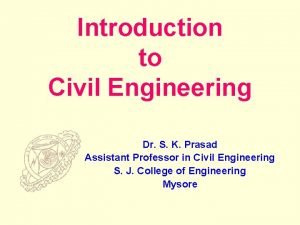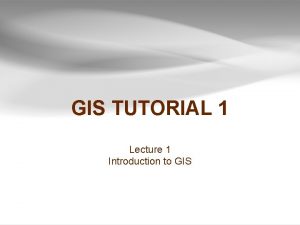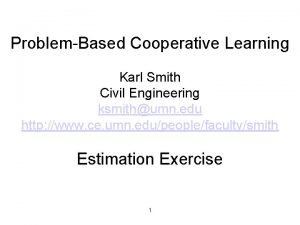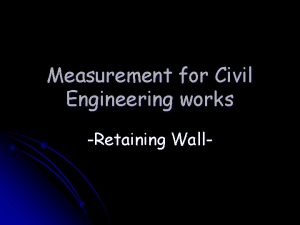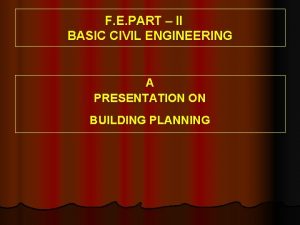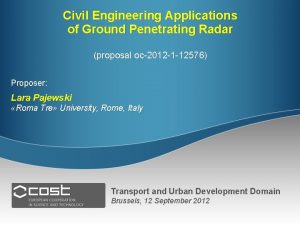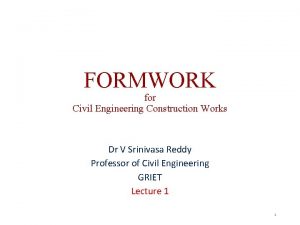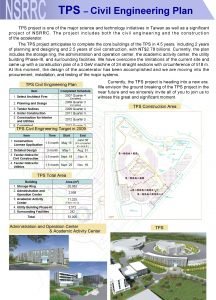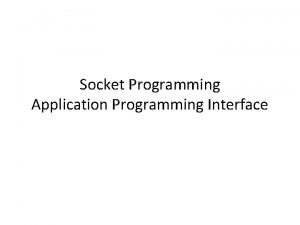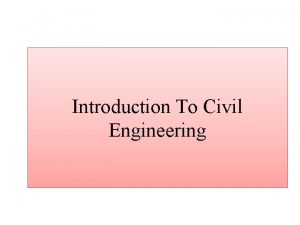Programming Application in Civil Engineering Application of Data






![curr=(struct node*)malloc(sizeof(struct node)); curr->row=i; curr->col=j; curr->data=a[i][j]; curr->link=NULL; if(head==NULL) head=curr; else { p=head; while(p->link!=NULL) p=p->link; curr=(struct node*)malloc(sizeof(struct node)); curr->row=i; curr->col=j; curr->data=a[i][j]; curr->link=NULL; if(head==NULL) head=curr; else { p=head; while(p->link!=NULL) p=p->link;](https://slidetodoc.com/presentation_image_h2/6fa3b2c4a8ade09c7f0e4dac8ab3c3bb/image-7.jpg)






















- Slides: 29

Programming Application in Civil Engineering - Application of Data Structure

Sparse Matrix • Matrices with relatively high proportion of zero or null entries are called sparse matrices. • When matrices are sparse, then much space and computing time could be saved if the non-zero entries were stored explicitly i. e. ignoring the zero entries the processing time and space can be minimized in sparse matrices. • • • In this matrix we have 6 rows and 7 columns. There are 5 nonzero entries out of 42 entries. It requires an alternate form to represent the matrix without considering the null entries.

• The alternate data structure that we consider to represent a sparse matrix is a triplet. • The triplet is a two dimensional array having t+1 rows and 3 columns. Where, t is total number of nonzero entries. • The first row of the triplet contains number of rows, columns and nonzero entries available in the matrix in its 1 st, 2 nd and 3 rd column respectively. Second row onwards it contains the row subscript, column subscript and the value of the nonzero entry in its 1 st, 2 nd and 3 rd column respectively. • Let us represent the above matrix in the following triplet of 6 rows and 3 columns • The above triplet contains only non-zero details by reducing the space for null entries.

Application of Linked List • Sparse Matrix Representation • Polynomial Representation • Dynamic Storage Management

Sparse Matrix Representation using linked list

struct node { int row; int col; int data; struct node *link; }*head=NULL, *curr=NULL, *p=NULL; main() { m=no. of rows n=no. of columns for(i=0; i<m; i++) { for(j=0; j<n; j++) { scanf("%d", &a[i][j]); if(a[i][j]!=0) {
![currstruct nodemallocsizeofstruct node currrowi currcolj currdataaij currlinkNULL ifheadNULL headcurr else phead whileplinkNULL pplink curr=(struct node*)malloc(sizeof(struct node)); curr->row=i; curr->col=j; curr->data=a[i][j]; curr->link=NULL; if(head==NULL) head=curr; else { p=head; while(p->link!=NULL) p=p->link;](https://slidetodoc.com/presentation_image_h2/6fa3b2c4a8ade09c7f0e4dac8ab3c3bb/image-7.jpg)
curr=(struct node*)malloc(sizeof(struct node)); curr->row=i; curr->col=j; curr->data=a[i][j]; curr->link=NULL; if(head==NULL) head=curr; else { p=head; while(p->link!=NULL) p=p->link; p->link=curr; } }//end of inner for loop }//end of outer for loop

p=head; if(head==NULL) printf("n. Sparse matrix empty!n"); else { while(p->link!=NULL) { printf("%d %d %d ", p->row, p->col, p->data); p=p->link; } printf("%d %d %d ", p->row, p->col, p->data); } }// end of main

Polynomial Representation • We want to represent the polynomial : • We will represent each term as a node containing coefficient and exponent fields, as well as a pointer to the next term. • Declarations: typedef struct poly_node *poly_pointer; typedef struct poly_node { int coef; int expon; poly_pointer link; };





Application of Stack • • Parenthesis Matching Tower of Hanoi Problem Quick Sort Recursion

Application: Parenthesis Matching • Problem: match the left and right parentheses in a character string • (a*(b+c)+d) – Left parentheses: position 0 and 3 – Right parentheses: position 7 and 10 – Left at position 0 matches with right at position 10 • (a+b))*((c+d) – (0, 4) – Right parenthesis at 5 has no matching left parenthesis – (8, 12) – Left parenthesis at 7 has no matching right parenthesis 15

Parenthesis Matching • (((a+b)*c+d-e)/(f+g)-(h+j)*(k-1))/(m-n) – Output pairs (u, v) such that the left parenthesis at position u is matched with the right parenthesis at v. (2, 6) (1, 13) (15, 19) (21, 25) (27, 31) (0, 32) (34, 38) • How do we implement this using a stack? 1. Scan expression from left to right 2. When a left parenthesis is encountered, add its position to the stack 3. When a right parenthesis is encountered, remove matching position from the stack 16

Example of Parenthesis Matching (((a+b)*c+d-e)/(f+g)-(h+j)*(k-1))/(m-n) stack 2 1 0 output – … 1 0 0 (2, 6) (1, 13) 15 0 0 (15, 19) 21 0 0 (21, 25) … Do the same for (a-b)*(c+d/(e-f))/(g+h) 17

Application: Towers of Hanoi • Read the ancient Tower of Brahma ritual • n disks to be moved from tower A to tower C with the following restrictions: – Move 1 disk at a time – Cannot place larger disk on top of a smaller one 18

Let’s solve the problem for 3 disks 19

Towers of Hanoi (1, 2) 20

Towers of Hanoi (3, 4) 21

Towers of Hanoi (5, 6) 22

Towers of Hanoi (7) • So, how many moves are needed for solving 3 disk Towers of Hanoi problem? 7 23

Time complexity for Towers of Hanoi • A very elegant solution is to use recursion. • The minimum number of moves required is 2 n-1 • Time complexity for Towers of Hanoi is Q(2 n), which is exponential! • Since disks are removed from each tower in a LIFO manner, each tower can be represented as a stack 24

Recursive Solution 1 A B C • n > 0 gold disks to be moved from A to C using B • move top n-1 disks from A to B using C 25

Recursive Solution 1 A B C • move top disk from A to C 26

Recursive Solution 1 A B C • move top n-1 disks from B to C using A 27

Recursive Solution • To move n rings from A to C using B as spare: • if n is 1 – just do it, • otherwise. . . – move n-1 rings from A to B using C as spare – move one ring from A to C – move n-1 rings from B to C using A as spare 28

#include <stdio. h> int n, A, B, C; /* number to move, source pole, destination pole and spare pole respectively */ void move(n, A, C, B) { if (n==1) { printf("Move from %d to %d. n", A, C); } else { move(n-1, A, B, C); move(1, A, C, B); move(n-1, B, C, A); } } main() { move(4, 1, 3, 2); }
 Bisection method application in civil engineering
Bisection method application in civil engineering System programming definition
System programming definition Civil rights webquest
Civil rights webquest Cven4104
Cven4104 Hse in civil engineering
Hse in civil engineering Risk management in civil engineering
Risk management in civil engineering Applications of grouting
Applications of grouting What is formwork in civil engineering
What is formwork in civil engineering Introduction to civil engineering
Introduction to civil engineering Role of civil engineering
Role of civil engineering Gis applications in civil engineering
Gis applications in civil engineering Czech technical university in prague civil engineering
Czech technical university in prague civil engineering Civil engg drawing house planning
Civil engg drawing house planning Umn civil engineering
Umn civil engineering Ndsu civil and industrial engineering building
Ndsu civil and industrial engineering building Length of retaining wall
Length of retaining wall Roominess in civil engineering
Roominess in civil engineering Civil engineering applications of ground penetrating radar
Civil engineering applications of ground penetrating radar Integrated design project civil engineering
Integrated design project civil engineering Civil engineering faculty
Civil engineering faculty Ub computer engineering flowsheet
Ub computer engineering flowsheet Caace gala
Caace gala Branch of civil engineering
Branch of civil engineering Workability of concrete ppt
Workability of concrete ppt Rtei
Rtei In civil engineering
In civil engineering Classification of formwork
Classification of formwork Eol jsc nasa gov
Eol jsc nasa gov Tps civil engineering
Tps civil engineering Civil engineering works
Civil engineering works









